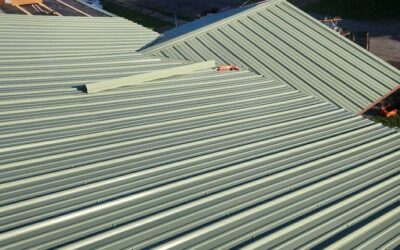Everything You Need to Know About Soffits on a Roof: Importance, Functions, and Repair
When it comes to roofing systems, one often overlooked but crucial component is the soffit. Most homeowners tend to focus on the roof shingles, gutters, or flashing, but the soffit plays an essential role in protecting the integrity of your home. In this blog, we will explore what soffits are, why they are so important, how to maintain them, and when they need repair or replacement.
Whether you are a new homeowner or someone who’s looking to learn more about your roof’s components, understanding the soffit and its importance will give you the insight you need to maintain a healthy, long-lasting roofing system.
What is a Soffit?
The soffit is the material that covers the underside of the eaves of a roof. In other words, it’s the exposed surface underneath the roof’s overhang. The soffit plays a key role in protecting the underlying roof structure and enhancing the overall ventilation system of your home.
Soffits are usually made from materials like wood, aluminum, vinyl, or composite materials. They are installed in such a way that they are visible from the exterior of the home, and they are typically vented to allow airflow into the attic or crawl space. Without properly installed soffits, your home could face a variety of problems, including poor ventilation, water damage, and pest infestations.
Functions of Soffits in a Roofing System
Soffits are much more than a decorative feature. In fact, they are critical in ensuring the longevity of your roofing system. Let’s take a closer look at the different functions of soffits.
1. Proper Ventilation
One of the primary functions of soffits is to promote proper attic ventilation. Soffits are often equipped with small vents that allow fresh air to flow into the attic. This constant airflow helps to regulate the temperature and moisture levels in the attic, preventing issues such as condensation, mold growth, and wood rot.
Attic ventilation is essential because it helps maintain a balanced temperature in the home. Without proper ventilation, the attic can get too hot in the summer, which may cause the shingles on the roof to age prematurely or deteriorate. In the winter, poor ventilation can trap warm air in the attic, leading to the formation of ice dams on the roof, which can result in water damage inside the home.
2. Protection Against Water Damage
Another important role of the soffit is to protect the roof structure from water damage. When the roof overhangs the exterior of the home, it provides protection to the siding, windows, and other structural elements from rain and snow. The soffit itself acts as a shield, helping to keep water from running down the walls of the house, which could lead to moisture damage, mold, and mildew growth.
Without soffits in place, water would pour off the roof edge, possibly causing damage to the siding, foundation, and landscaping. Soffits prevent water from seeping into vulnerable areas of your home.
3. Preventing Pests from Entering the Roof Space
Soffits are designed to prevent pests like insects, birds, and rodents from entering the attic or roof space. By covering the underside of the roof overhang, soffits help to create a barrier between your home and these unwanted invaders.
While soffits are typically vented to allow for airflow, they are designed with small, protective screens or mesh to ensure that pests cannot squeeze through the openings. Without soffits, pests could easily access the attic, causing damage to insulation, electrical wires, and structural elements.
4. Aesthetic Appeal
Although not its primary function, soffits also contribute to the overall aesthetic appeal of your home. They provide a finished, clean look to the roofline by concealing the rafters, which are usually less aesthetically pleasing. Properly installed soffits enhance the curb appeal of your home by giving it a polished, well-maintained appearance.
The material and color of the soffit can also complement the overall design of the home, making it an important element of the exterior design. In many cases, soffits are available in various colors and materials to match the exterior style of your home.
Materials Used for Soffits
When it comes to soffits, several materials are available, each offering specific advantages depending on your preferences, budget, and the climate of your area. Here are the most common materials used for soffits:
1. Wood
Wooden soffits are a traditional option that provides a natural, classic look to your home. However, wood is more susceptible to moisture damage, warping, and rotting over time, especially in areas with high humidity or heavy rainfall. If you choose wood for your soffits, regular maintenance such as sealing or painting is essential to prolong the lifespan of the material.
2. Vinyl
Vinyl soffits are a popular choice due to their low maintenance requirements. They are resistant to moisture, rotting, and warping, making them ideal for areas with high humidity or frequent rain. Vinyl soffits are also available in a wide range of colors and styles, offering a more versatile option for homeowners. Additionally, vinyl soffits are relatively easy to install and are a cost-effective choice for many homeowners.
3. Aluminum
Aluminum soffits are known for their durability and resistance to weathering, rust, and corrosion. Like vinyl, aluminum soffits are low-maintenance, but they may not offer as many style options as vinyl. Aluminum soffits are often available in vented versions to allow for adequate airflow into the attic.
4. Composite
Composite materials combine the benefits of wood and synthetic materials. Composite soffits offer the aesthetic appeal of wood with enhanced durability and resistance to moisture and pests. These soffits are also low-maintenance and can last for many years, making them a great choice for homeowners who want a balance between style and durability.
Signs of Damaged or Failing Soffits
Soffits are exposed to the elements, which means they can become damaged or worn over time. Regular inspection of your soffits can help you identify issues before they escalate into larger, more expensive repairs. Here are some common signs that your soffits may need attention:
1. Visible Holes or Cracks
If you notice holes, cracks, or gaps in your soffits, it’s important to address the problem as soon as possible. Holes can allow pests to enter the attic, and cracks can compromise the structural integrity of the soffit. Left unaddressed, these issues could lead to water damage or further deterioration of the soffit material.
2. Sagging Soffit
If the soffit appears to be sagging or pulling away from the roofline, it could indicate a more serious issue. This could be caused by water damage, mold, or improper installation. Sagging soffits should be repaired immediately to prevent further structural damage to the roof.
3. Mold or Mildew Growth
Mold or mildew on the soffit surface can be a sign of excessive moisture buildup. This is often caused by inadequate ventilation or water damage. Mold not only damages the soffit material, but it can also spread to the attic or other parts of the home, creating health hazards.
4. Rot or Decay
Wooden soffits are especially susceptible to rot if they are exposed to moisture over long periods of time. If you notice soft spots, discolored areas, or a musty smell, it could be a sign of wood rot. Rotting soffits should be replaced immediately to avoid further damage to your roof structure.
How to Repair or Replace Soffits
Soffit repair or replacement can be a straightforward task for homeowners who are handy with basic tools. However, if the damage is extensive or involves structural issues, it’s best to call a professional roofer or contractor. Here is a general overview of the repair or replacement process:
1. Inspect the Damage
Before you begin any repairs, inspect the soffit to assess the extent of the damage. Look for signs of rot, mold, sagging, cracks, or holes. If the damage is localized, you may only need to replace a small section of the soffit. However, if the soffit has widespread damage, it may be best to replace the entire system.
2. Remove the Old Soffit
If you’re replacing the soffit, use a pry bar to carefully remove the old material. Be sure to remove any nails or screws holding the soffit in place. If the soffit is nailed into place, you may need to use a hammer or screwdriver to remove the nails or screws. Be cautious not to damage other parts of the roof structure or fascia.
3. Install the New Soffit
Once the old soffit has been removed, measure and cut the new soffit material to fit the space. If you’re using a vented soffit, make sure the vents are properly aligned for optimal airflow. Install the new soffit by securing it to the fascia or roof structure with nails or screws. Ensure the soffit is level and securely fastened.
4. Seal and Finish
After installing the new soffit, seal any gaps or seams to prevent moisture from entering the roof space. If the soffit is made of wood, apply a coat of sealant or paint to protect it from moisture and sun damage. Regularly inspect your soffit to ensure it remains in good condition.
Conclusion
Soffits are a crucial component of your roofing system that provide ventilation, prevent water damage, protect your attic from pests, and enhance the overall appearance of your home. Proper maintenance and timely repairs can ensure your soffits perform their essential functions for many years to come.
Whether you’re dealing with a minor issue like mold growth or more serious damage such as sagging or rot, it’s important to address soffit problems early to avoid more extensive damage to your home. If you’re unsure about repairing your soffits yourself, consider consulting a professional roofing contractor to ensure the work is done correctly and safely.
By understanding the role of soffits and knowing how to care for them, you can help maintain the health and longevity of your roof and your home.
 (440) 307-2060
(440) 307-2060


